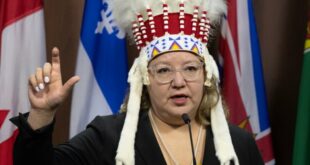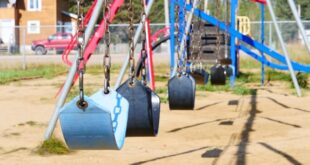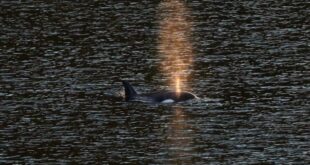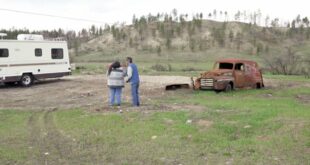New strategy to free 2-year-old whale could include lifting the whale out with a sling

A rescue team working to coax a stranded killer whale calf from a lagoon off northern Vancouver Island is prepared to change tactics to save its life, including the possibility of lifting the orca out to the open ocean, says a Fisheries Department marine mammal co-ordinator.
Paul Cottrell said Wednesday that all contingencies will be considered over the coming days after efforts by a team of experts and First Nations members failed to get the two-year-old to leave the remote lagoon through a narrow passage during high tide.
He said they won't rule out a "live-capture" scenario, which could involve placing the orca in a sling-type device and hoisting it to the open ocean.
"We are thinking beyond if we have to change tactics, depending on the calf's health going forward,'' said Cottrell at a news conference with Ehattesaht First Nation Chief Simon John in Zeballos, located more than 450 kilometres north of Victoria.
Several attempts have been made to get the calf to leave the area after its pregnant mother died in the lagoon Saturday when she was stranded by the low tide.
Attempts to use recorded killer whale vocalizations to convince the calf to leave the lagoon have not been successful.
Despite the difficulties, Cottrell said the team will be back on the water Thursday, continuing to try and coax the whale out.
"We're looking at all contingencies and contingencies later on,'' said Cottrell. "As you can imagine, this is a very short time window we have, so we're having to look at all those options and think ahead in case we have to look at those later options, which is in progress for sure.''
The whale has not been eating and Cottrell said that for it to survive once it's freed, it will need to be reunited with its pod, or adopted by another pod.
John said he hopes the orca will reunite with its family members.
"My real concern is that the whale gets out of the lagoon safely and reaches its pod,'' he said. "That's kind of where the real collaborative effort is at. We're really trying to get to that point of actually getting it out of there.''
John said the area of the lagoon is known locally as Little Espinosa and is considered prime seal hunting waters for killer whales.
A necropsy of the mother orca, a 15-year-old Bigg's killer whale, showed she was pregnant with a female fetus when she died.
Cottrell said the pregnancy may have contributed to the mother's death as it could not manoeuvre itself off the beach when it became stranded despite the help of local residents.
"The effort was incredible, and just an unlucky situation,'' said Cottrell, adding the mother orca could have weighed between eight and 10 tonnes.
The lagoon poses access challenges, especially for an orca calf left alone without its mother acting as a guide in and out of the area, he said. He said boats involved in the rescue effort can find it tricky to get into the lagoon.
"It's almost like threading the needle,'' said Cottrell about the entrance and exit to the lagoon, which includes short optimum tidal times of about 15 to 20 minutes and tricky currents.
Cottrell, who has been doing this work for 17 years, said this is one of the most difficult rescue scenarios he's been involved with.
John said nation members have been out looking for the calf's family in open water and have given the young calf a name: kwiisahi?is, meaning Brave Little Hunter.
He said First Nations members conducted a ceremony to honour the mother killer whale.
"We tried to release the whale's spirit with a ceremony.''
John said earlier that killer whales have an important connection to the Ehattesaht First Nation's culture, where its stories say "the killer whale came onto land and transformed into the wolf and then the wolf transformed into man.''
– With files from CBC News
*****
Credit belongs to : www.cbc.ca
 MaharlikaNews | Canada Leading Online Filipino Newspaper Portal The No. 1 most engaged information website for Filipino – Canadian in Canada. MaharlikaNews.com received almost a quarter a million visitors in 2020.
MaharlikaNews | Canada Leading Online Filipino Newspaper Portal The No. 1 most engaged information website for Filipino – Canadian in Canada. MaharlikaNews.com received almost a quarter a million visitors in 2020.







